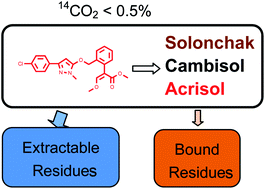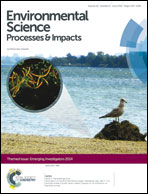Fate of a novel strobilurin fungicide pyraoxystrobin in flooded soil†
Abstract
Pyraoxystrobin, ((E)-2-(2-((3-(4-chlorophenyl)-1-methyl-1H-pyrazol-5-yloxy) methyl) phenyl)-3-methoxyacrylate) is a novel strobilurin fungicide with excellent and broad spectrum antifungal efficiency. Environmental behaviors of the new fungicide must be assessed to understand its potential risks to the environment. In this study, the extractable residues, bound residues and mineralization, as well as the dissipation rates of pyraoxystrobin were investigated in three flooded soils using a 14C tracing technique. Results showed that pyraoxystrobin didn't undergo appreciable dissipation during the 100 day incubation period in some tested soils, with 70.01%, 28.58% and 83.85% of the parent compound remaining in the solonchak, cambisol and acrisol soils at the end of the experiment, respectively. Almost no 14C-pyraoxystrobin was mineralized to 14CO2 (<0.5%) over the experimental period. Organic matter had a dominating influence on the bound residues formation and the fractions of bound residues increased as the soil organic matter content increased. Less than 9% of the radioactivity was found in the aqueous phase, while the majority of extractable residues (>65.39%) were recovered in the organic extracts. This study aims to give a deep insight into the environmental behaviors of pyraoxystrobin and may be beneficial for the risk assessment of other analogous fungicides.


 Please wait while we load your content...
Please wait while we load your content...